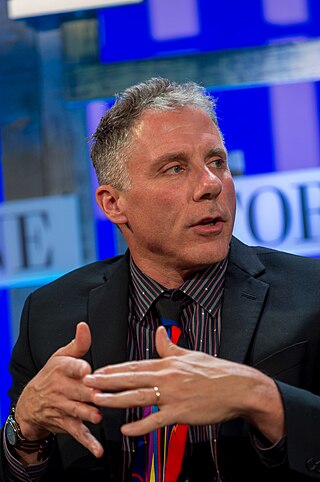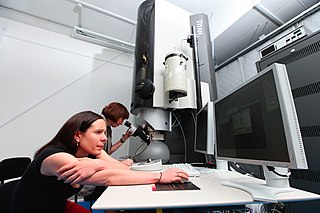Related Research Articles
Photoemission electron microscopy is a type of electron microscopy that utilizes local variations in electron emission to generate image contrast. The excitation is usually produced by ultraviolet light, synchrotron radiation or X-ray sources. PEEM measures the coefficient indirectly by collecting the emitted secondary electrons generated in the electron cascade that follows the creation of the primary core hole in the absorption process. PEEM is a surface sensitive technique because the emitted electrons originate from a shallow layer. In physics, this technique is referred to as PEEM, which goes together naturally with low-energy electron diffraction (LEED), and low-energy electron microscopy (LEEM). In biology, it is called photoelectron microscopy (PEM), which fits with photoelectron spectroscopy (PES), transmission electron microscopy (TEM), and scanning electron microscopy (SEM).

A scanning transmission electron microscope (STEM) is a type of transmission electron microscope (TEM). Pronunciation is [stɛm] or [ɛsti:i:ɛm]. As with a conventional transmission electron microscope (CTEM), images are formed by electrons passing through a sufficiently thin specimen. However, unlike CTEM, in STEM the electron beam is focused to a fine spot which is then scanned over the sample in a raster illumination system constructed so that the sample is illuminated at each point with the beam parallel to the optical axis. The rastering of the beam across the sample makes STEM suitable for analytical techniques such as Z-contrast annular dark-field imaging, and spectroscopic mapping by energy dispersive X-ray (EDX) spectroscopy, or electron energy loss spectroscopy (EELS). These signals can be obtained simultaneously, allowing direct correlation of images and spectroscopic data.

The Department of Materials at the University of Oxford, England was founded in the 1950s as the Department of Metallurgy, by William Hume-Rothery, who was a reader in Oxford's Department of Inorganic Chemistry. It is part of the university's Mathematical, Physical and Life Sciences Division

Harry Albert Atwater, Jr. is an American physicist and materials scientist and is the Otis Booth Leadership Chair of the Division of Engineering and Applied Science at the California Institute of Technology. Currently he is the Howard Hughes Professor of Applied Physics and Materials Science and the Director for the Liquid Sunlight Alliance (LiSA), a Department of Energy Hub program for solar fuels. Atwater's scientific effort focuses on nanophotonic light-matter interactions and solar energy conversion. His current research in energy centers on high efficiency photovoltaics, carbon capture and removal, and photoelectrochemical processes for generation of solar fuels. His research has resulted in world records for solar photovoltaic conversion and photoelectrochemical water splitting. His work also spans fundamental nanophotonic phenomena, in plasmonics and 2D materials, and also applications including active metasurfaces and optical propulsion.

Rafal Edward Dunin-Borkowski HonFRMS is a British experimental physicist. He is currently Director of the Institute for Microstructure Research (PGI-5) and the Ernst Ruska-Centre for Microscopy and Spectroscopy with Electrons (ER-C) in Forschungszentrum Jülich and Professor of Experimental Physics in RWTH Aachen University.

Ultramicroscopy is an established peer-reviewed scientific journal in the field of electron microscopy. The journal editor-in-chief is Professor Angus Kirkland and it is published by Elsevier. It provides a forum for the publication of original research papers, invited reviews and rapid communications. The scope of Ultramicroscopy is to describe advances in instrumentation, methods and theory related to all modes of microscopical imaging, diffraction and spectroscopy in the life and physical sciences.

Ondrej L. Krivanek is a Czech/British physicist resident in the United States, and a leading developer of electron-optical instrumentation. He won the Kavli Prize for Nanoscience in 2020 for his substantial innovations in atomic resolution electron microscopy.

Paul Anthony Midgley FRS is a Professor of Materials Science in the Department of Materials Science and Metallurgy at the University of Cambridge and a fellow of Peterhouse, Cambridge.
Karen Chan is an associate professor at the Technical University of Denmark. She is a Canadian and French physicist most notable for her work on catalysis, electrocatalysis, and electrochemical reduction of carbon dioxide.

Liquid-phase electron microscopy refers to a class of methods for imaging specimens in liquid with nanometer spatial resolution using electron microscopy. LP-EM overcomes the key limitation of electron microscopy: since the electron optics requires a high vacuum, the sample must be stable in a vacuum environment. Many types of specimens relevant to biology, materials science, chemistry, geology, and physics, however, change their properties when placed in a vacuum.

Thomas Benjamin Britton is a materials scientist and engineer based at The University of British Columbia. He is a specialist in micromechanics, electron microscopy and crystal plasticity. In 2014 he was awarded the Silver Medal of the Institute of Materials, Minerals and Mining (IOM3), a society of which he then became a Fellow in 2016.

Dr. Dan Thomas Major is a Professor of Chemistry at Bar Ilan University specializing in Computational Chemistry.

Sarah Jane Haigh is a Professor in the School of Materials at the University of Manchester. She investigates nanomaterials using transmission electron microscopy, including two-dimensional materials such as graphene.
Pinshane Yeh Huang is an Associate Professor of Materials Science at the University of Illinois at Urbana–Champaign. She develops transmission electron microscopy to investigate two-dimensional materials. During her PhD she discovered the thinnest piece of glass in the world, which was included in the Guinness World Records. Huang was awarded the 2019 Presidential Early Career Award for Scientists and Engineers.
John Marius Rodenburg is Professor in the Department of Electronic and Electrical Engineering at the University of Sheffield.
Thermal shock synthesis (TSS) is a method in which materials are synthesized via rapid, high-temperature heating. In the TSS process, temperatures as high as 3000 K are applied for a duration of just seconds or milliseconds, followed by rapid cooling (a TSS image shown in Fig. 1). In this regard, TSS is distinct from conventional high-temperature syntheses that feature slow and near-equilibrium heating at limited temperature ranges (e.g., 1500 K for furnace heating) for extended periods of time (typically hours) and generally slow heating and cooling (~10 K/min).
Joanne Etheridge is an Australian physicist. She is Director of the Monash Centre for Electron Microscopy and Professor in the Department of Materials Science and Engineering at Monash University.

Zhong Lin Wang is a Chinese-American physicist, materials scientist and engineer specialized in nanotechnology, energy science and electronics. He received his PhD from Arizona State University in 1987. He is the Hightower Chair in Materials Science and Engineering and Regents' Professor at the Georgia Institute of Technology, US.
4D scanning transmission electron microscopy is a subset of scanning transmission electron microscopy (STEM) which utilizes a pixelated electron detector to capture a convergent beam electron diffraction (CBED) pattern at each scan location. This technique captures a 2 dimensional reciprocal space image associated with each scan point as the beam rasters across a 2 dimensional region in real space, hence the name 4D STEM. Its development was enabled by evolution in STEM detectors and improvements computational power. The technique has applications in visual diffraction imaging, phase orientation and strain mapping, phase contrast analysis, among others.
Angus J Wilkinson is a professor of materials science based at University of Oxford. He is a specialist in micromechanics, electron microscopy and crystal plasticity. He assists in overseeing the MicroMechanics group while focusing on the fundamentals of material deformation. He developed the HR-EBSD method for mapping stress and dislocation density at high spatial resolution used at the micron scale in mechanical testing and micro-cantilevers to extract data on mechanical properties that are relevant to materials engineering.
References
- ↑ Kirkland, A. I.; Saxton, W. O.; Chau, K. -L.; Tsuno, K.; Kawasaki, M. (1995-03-01). "Super-resolution by aperture synthesis: tilt series reconstruction in CTEM". Ultramicroscopy. 57 (4): 355–374. doi:10.1016/0304-3991(94)00191-O. ISSN 0304-3991.
- 1 2 "Angus Kirkland". www.materials.ox.ac.uk. Retrieved 2022-11-13.
- ↑ "Angus Kirkland". scholar.google.com. Retrieved 2022-11-13.
- ↑ "Angus I. Kirkland | University of Oxford | 307 Publications | 9194 Citations | Related Authors". SciSpace - Author. Retrieved 2022-11-13.
- 1 2 3 4 "Angus Kirkland - - Diamond Light Source". www.diamond.ac.uk. Retrieved 2022-11-13.
- 1 2 3 4 "Science Director - Professor Angus Kirkland". Rosalind Franklin Institute. Retrieved 2022-11-13.
- ↑ "Oxford Electron Image Analysis Group - Oxford Electron Image Analysis Group". www-eia.materials.ox.ac.uk. Retrieved 2022-11-13.
- 1 2 3 "Lab profile: Angus Kirkland, University of Oxford". Materials Today. Retrieved 2022-11-13.
- ↑ "Oxford Electron Image Analysis Group - Professor Angus Kirkland". www-eia.materials.ox.ac.uk. Retrieved 2022-11-13.
- ↑ "Prof Angus Kirkland". The ImagingBioPro Network. Retrieved 2022-11-13.
- ↑ "Kirkland, Angus - University of Oxford - Department of Materials". www.x-mol.com. Retrieved 2022-11-13.
- ↑ "Speakers". femms2017.org. Retrieved 2022-11-13.
- 1 2 Peng, Lele; Wei, Ziyang; Wan, Chengzhang; Li, Jing; Chen, Zhuo; Zhu, Dan; Baumann, Daniel; Liu, Haotian; Allen, Christopher S.; Xu, Xiang; Kirkland, Angus I.; Shakir, Imran; Almutairi, Zeyad; Tolbert, Sarah; Dunn, Bruce (September 2020). "A fundamental look at electrocatalytic sulfur reduction reaction". Nature Catalysis. 3 (9): 762–770. doi:10.1038/s41929-020-0498-x. ISSN 2520-1158. S2CID 221381477.
- ↑ Fei, Huilong; Dong, Juncai; Feng, Yexin; Allen, Christopher S.; Wan, Chengzhang; Volosskiy, Boris; Li, Mufan; Zhao, Zipeng; Wang, Yiliu; Sun, Hongtao; An, Pengfei; Chen, Wenxing; Guo, Zhiying; Lee, Chain; Chen, Dongliang (January 2018). "General synthesis and definitive structural identification of MN4C4 single-atom catalysts with tunable electrocatalytic activities". Nature Catalysis. 1 (1): 63–72. doi:10.1038/s41929-017-0008-y. ISSN 2520-1158. S2CID 103450647.
- ↑ Robertson, Alex W.; Allen, Christopher S.; Wu, Yimin A.; He, Kuang; Olivier, Jaco; Neethling, Jan; Kirkland, Angus I.; Warner, Jamie H. (2012-10-23). "Spatial control of defect creation in graphene at the nanoscale". Nature Communications. 3 (1): 1144. Bibcode:2012NatCo...3.1144R. doi: 10.1038/ncomms2141 . ISSN 2041-1723. PMID 23093181.
- ↑ Meyer, Rüdiger R.; Sloan, Jeremy; Dunin-Borkowski, Rafal E.; Kirkland, Angus I.; Novotny, Miles C.; Bailey, Sam R.; Hutchison, John L.; Green, Malcolm L. H. (2000-08-25). "Discrete Atom Imaging of One-Dimensional Crystals Formed Within Single-Walled Carbon Nanotubes". Science. 289 (5483): 1324–1326. Bibcode:2000Sci...289.1324M. doi:10.1126/science.289.5483.1324. ISSN 0036-8075. PMID 10958773.
- ↑ Warner, Jamie H.; Margine, Elena Roxana; Mukai, Masaki; Robertson, Alexander W.; Giustino, Feliciano; Kirkland, Angus I. (2012-07-13). "Dislocation-Driven Deformations in Graphene". Science. 337 (6091): 209–212. Bibcode:2012Sci...337..209W. doi:10.1126/science.1217529. ISSN 0036-8075. PMID 22798609. S2CID 39088552.
- ↑ "Angus Kirkland - GTR".
- ↑ "Rosalind Franklin Institute invest £1.55m for unique electron microscope". EurekAlert!. Retrieved 2022-11-13.
- ↑ Weller, Olaf (2019-11-13). "Exclusive interview with Prof. Angus Kirkland, RFI, UK". DENSsolutions. Retrieved 2022-11-13.
- ↑ "Ultramicroscopy | Journal". ScienceDirect.com by Elsevier. Retrieved 2022-11-13.
- ↑ "Microscopy Society of America Award for the best paper published (2005) - Google Search". www.google.com. Retrieved 2022-11-13.
- ↑ "Oxford Electron Image Analysis Group - Oxford Electron Image Analysis Group". www-eia.materials.ox.ac.uk. Retrieved 2022-11-13.
- ↑ Labmate, International. "Royal Microscopical Society Medal Series - Winners Announced". Labmate Online. Retrieved 2022-11-13.
- ↑ Mel. "Alan Agar Award for Electron Microscopy". www.rms.org.uk. Retrieved 2022-11-13.
- ↑ "VISITOR SNAPSHOT: Professor Angus Kirkland (Oxford University, United Kingdom) and Professor Peter van Aken (Max Planck Institute, Germany) both Honorary Professors at the Nelson Mandela University visited the Centre for HRTEM for a specialist lecture series". Twitter. Retrieved 2022-11-13.